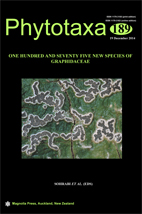Abstract
Fourteen species of the lichen family Graphidaceae from southern Thailand are described as new, namely Creographa subbrasiliensis, which is similar to C. brasiliensis but without chemistry; Diorygma angusticarpum, which differs from D. hieroglyphicum by a I+ blue hymenium and lirellae with a slit-like disc; D. chumphonense, distinguished by its small, densely muriform ascospores and production of salazinic and norstictic acids; D. citri, distinguished by a I- hymenium and a complex chemistry including salazinic and hypostictic acids as major metabolites; D. conprotocetraricum, which is unique by its chemistry, i.e. conprotocetraric acid as a major substance; D. fuscopruinosum with a brown pruina on the disc of the apothecium and comparatively small ascospores; D. hieroglyphicellum, which is similar to D. hieroglyphicum but differs by much smaller ascospores; D. inexpectatum, which is distinguished by its chemistry (salazinic and hypostictic acids) and a I+ blue hymenium; D. salazinicum, separated from D. pruinosum by its rare chemistry (stictic and salazinic acids as ± major metabolites); D. subpruinosum, distinguished by often 2-spored asci and protocetraric and hypostictic acids as major constituents; D. thailandicum, which is similar to D. pruinosum, but differs by protocetraric and stictic acid as major metabolites; Graphis australosiamensis, distinguished by one muriform ascospore per ascus, a laterally carbonized exciple and norstictic acid in the thallus; Ocellularia palianensis, distinguished by small, transversely septate ascospores and by producing two unknown substances; and Platygramme microspora, which is distinguished by very small transseptate ascospores and producing stictic acid and its satellites.

